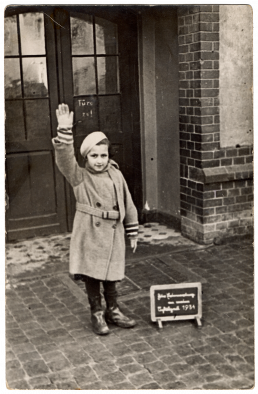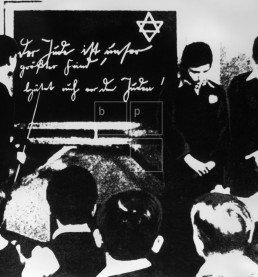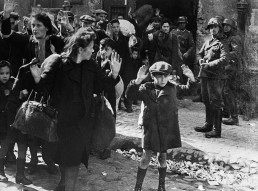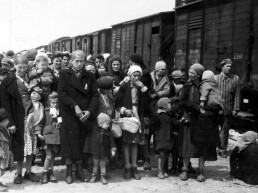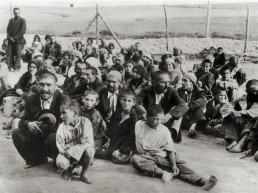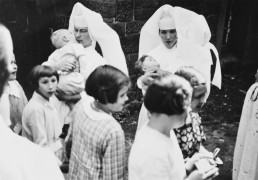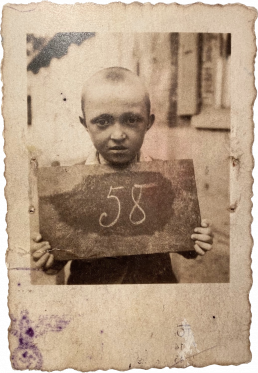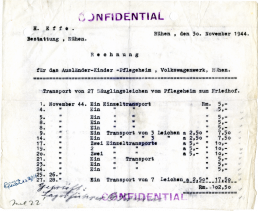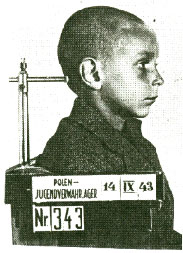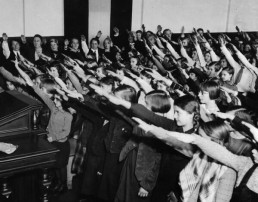Excluded – Persecuted – Murdered
Children of Gemeinschaftsfremden (lit.: strangers to the community, those people who were not considered to be part of the Volksgemeinschaft) were marginalized and persecuted in the Nazi state. The National Socialists killed thousands of disabled boys and girls in euthanasia institutions. 1.5 million Jewish children and teenagers as well as an unknown number of young Sinti and Roma perished. They died in ghettos and camps as a result of hunger, violence and forced labor, were shot by death squads or suffocated in gas chambers.
Many children from the Soviet Union and Poland were brought to Germany, sometimes with their parents, for forced labor. The minimum age for foreign civilian workers was lowered further and further during the war. Tens of thousands of babies born to foreign forced laborers died in German custody.
Young people in Germany also had to reckon with persecution if they managed to evade the total grip of the state. Tens of thousands were sent to youth concentration camps after having been classified as members of oppositional youth groups or as “difficult.”
9-year-old Jewish schoolgirl Alice Rosenthal was forced to pose giving the Hitler salute for her school photo in Wiesbaden, 1934.
After the handover of power to the National Socialists in 1933, Jewish students were still allowed to attend public schools. After the pogroms in November 1938, they were forbidden to do so.
(United States Holocaust Memorial Museum)
Humiliation of Jewish boys in front of their non-Jewish classmates in a Viennese school, 1938.
On the blackboard is written: “The Jew is our greatest enemy! – Beware of the Jew!” Beginning in 1938, Jewish children were no longer allowed to attend public schools in the German Reich, which included Austria.
(bpk)
Men of the SS lead away Jewish women and children after the suppression of the Warsaw Ghetto Uprising, May 16, 1943.
Presumably, almost none of the people taken away survived. It was long believed that the boy with his hands up was Zvi Nussbaum (1935-2012), a survivor of the Bergen-Belsen Concentration Camp. Recent research suggests that may not be the case.
(bpk)
Arrival of a transport train at the ramp of the Auschwitz-Birkenau Concentration Camp, May 1944.
In 1944, the SS deported over 400,000 Jews from Hungary to Auschwitz, including many children. At the train ramp, SS doctors deemed most of the children unfit for work and sent them to the gas chambers. Some managed to pass themselves off as older to avoid certain immediate death. Several thousand children were transferred to other concentration camps, including Buchenwald and Mittelbau-Dora.
The photo is from an SS album.
(Yad Vashem)
Sinti and Roma in the Belzec labor camp, 1940.
In the spring of 1940, Sinti and Roma who had been deported from the German Reich were imprisoned in the camp in occupied Poland. They were transferred to another camp in May 1940. Later, the SS used the Bełżec site as an extermination camp for Jews.
(akg-images / Fototeca Gilardi)
Removal of children from the Antonius children’s home in Fulda, 21 July 1937.
43 children with disabilities were moved to a home in Treysa (Hesse). About half of them were later murdered in the Hadamar euthanasia institute. The other children survived thanks to a nurse’s rescue efforts.
(Antonius gGmbH, Fulda)
Invoice for the transport of infant corpses, 30 November 1944.
The children born to foreign forced laborers died in a “foreign children’s care institution” run by the Volkswagen plant. In total, several ten-thousands of foreign children starved to death in such homes between 1943 and 1945. This document from Rühen, near Wolfsberg, served as evidence in a British war crimes trial.
(The National Archives, London)
ID photo of an unknown boy in the Kinder KZ Litzmannstadt (Łódź), November 1943.
Between 1942 and 1945, more than 10,000 Polish children and teenagers up to the age of 16 were imprisoned in this camp in annexed western Poland. They had been arrested as relatives of resistance fighters, for neglect or theft of food. There were concentration camps for German children in Moringen and in Ravensbrück.
(Zukunft braucht Erinnerung)
"All ringleaders [...] are to be sent to a concentration camp. There the young people must first of all be beaten and then be drilled harshly and made to work [...] The stay in the concentration camp for these youth must be a longer one, 2-3 years. It must be clear that they will never be allowed to attend university again [...] Only if we take brutal action will we be able to avoid the dangerous spread of this Anglophile tendency at a time when Germany is fighting for its existence [...] I ask that this action be carried out in agreement with the Gauleiters and the Higher SS and police leaders.Heil Hitler Ihr H. H."
Swing Kids to concentration camp: excerpt from Heinrich Himmler's letter, 26 January 1942.
The Swing Kids were an oppositional youth movement represented in many major German cities. Swing did not conform to the ideas of National Socialist ideology and was considered degenerate music. SS chief Heinrich Himmler called for a police crackdown and for the young people to be sent to concentration camps.
(Bundesarchiv)
Herrenkinder and Outcasts
Integration into the Volksgemeinschaft
Nazi propaganda persuaded the children of the Volksgenossen that they were part of a superior Volksgemeinschaft (national community), giving them the feeling that they belonged to a…
